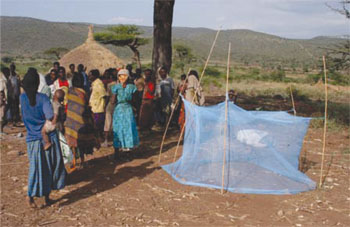Clarifying the problem of malaria infection in your community
Perhaps you are concerned about the amount of malaria that is present in your kebele. There are two steps that you can take to clarify the problem.
Step 1: Find out as much as you can about the problem. For example:
- How many new cases of malaria occur every month or every year?
- How are the cases of malaria distributed in your community? Are they more common in one area than another?
- Do people in your community think that malaria is a health problem that needs to be addressed (or do they think it is a 'fact of life' that cannot be resolved)?
- What available services are there to address malaria in your kebele or woreda?
- Are there any specific risk factors for malaria locally, e.g. stagnant water bodies in the surrounding community, or perhaps there is a lack of proper utilisation of the ITNs, or perhaps there is low awareness about the way that malaria is spread?
Step 2: Discover whether the interventions that are already in place are effective, and if they are not, what are the reasons? For example, with respect to the ITN distribution throughout your kebele, you may want to find out:
- What is the standard household coverage of ITNs locally (i.e. how many nets per household)?
- Is there additional coverage of ITNs for pregnant women and children under five years of age?
- Has the training about how to hang and maintain ITNs been well accepted by the community (Figure 13.2)?

Figure 13.2 Research into the way that preventive activities to reduce the amount of malaria in your district might look at the way that training in the use of ITNs has been conducted. (Photo: UNICEF Ethiopia/Indrias Getachew)
Last modified: Wednesday, 25 June 2014, 7:31 PM